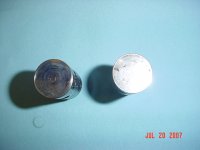kurts100
Senior Member
Offline
My 100 had the engine rebuilt back in '02 and since then I've put no more than 1500 miles on. Last Fall I noticed the rocker assembly making more noice than usual so this Spring I had it rebuilt, as this was not done when the engine was rebuilt. When I put the new shaft on, the previous owner had removed the pedestal studs and used 3/8" BSF bolts all the same length(I assumed these bolts were original). When tightening these bolts, one was very loose and stripped (too short a bolt on the high side of the pedestal). Hoping I still had some thread in the hole and after realizing the bolts were wrong, I ordered the correct studs, but when torqueing to 20lbs it stripped at about 10 or 15lbs. Not a good feeling. I ordered the correct Helicoil and installed and now have the rocker shaft properly mounted. When I started the engine it was still making alot of noice under the valve cover. I happened to check the oil and it was a milky white which is when I realized Anti-freeze had been leaking out of that semi-striped hole and running down the holes for the push rods and into the sump. Changed oil and filter and eliminated the leak but still very noisy.
My question is could this have damaged either the cam, cam bearings, tappets or pushrods which is why I'm getting all the noice from the rocker assembly. I've triple checked my valve clearances but the noice continues. I've run 10W30 since the rebuild but this time I used 10W40.
Thanks,
Kurt (Frustrated)
My question is could this have damaged either the cam, cam bearings, tappets or pushrods which is why I'm getting all the noice from the rocker assembly. I've triple checked my valve clearances but the noice continues. I've run 10W30 since the rebuild but this time I used 10W40.
Thanks,
Kurt (Frustrated)

 Hi Guest!
Hi Guest!

 smilie in place of the real @
smilie in place of the real @
 Pretty Please - add it to our Events forum(s) and add to the calendar! >>
Pretty Please - add it to our Events forum(s) and add to the calendar! >> 

